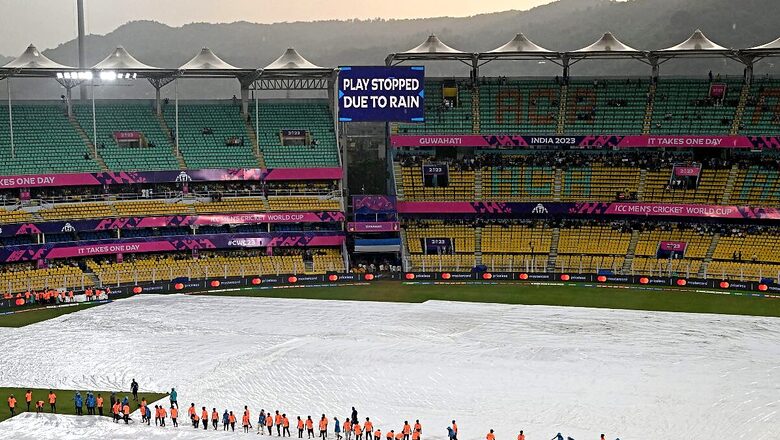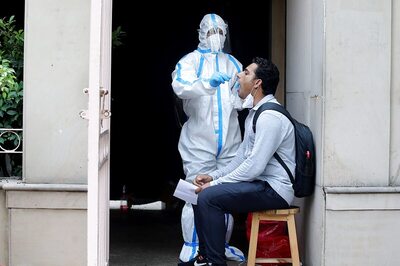
views
It has been over sixteen years since the Board of Control for India (BCCI) started using the V Jayadevan (VJD) method for its domestic competitions. After an initial trial run of six months in 2006, the Indian cricket board has been using the method used for calculating targets in rain-truncated limited overs fixtures but continues to ignore it for its biggest property.
At a time when the entire country is seeing a wave of “Make in India”, the Indian Premier League (IPL), the biggest T20 league in the world, is still using an overseas method for calculations.
Also Read: BCCI Reworking IPL Schedule to Avoid Clashes With Polling Dates
The Duckworth–Lewis–Stern (DLS) method, formally adopted by the International Cricket Council (ICC), continues to be the BCCI’s preference even when it uses the VJD method for all its domestic fixtures. Not just the BCCI tournaments, even state T20 leagues like the Tamil Nadu Premier League (TNPL) use the VJD method but it is yet to even get a trial run for the IPL.
Founder V Jayadevan has relentlessly knocked the BCCI’s doors but has returned disappointed due to lack of interest from the office bearers. He last had an interaction with BCCI General Manager Abey Kuruvilla in March 2023 and was assured a meeting to discuss the possibility of using VJD for IPL 2024. Some communication followed but there has been no dialogue for over six months now.
“There has been no dialogue with the BCCI in over six months. Last time I met BCCI officials was back in March 2023 where Abey Kuruvilla told me that he will arrange a meeting to discuss the possibility of using VJD method for IPL 2024. I don’t know why BCCI is averse to using it in the IPL when all other domestic competitions and leagues in the country use this. IPL is also India’s domestic T20 league,” says Jayadevan.
IPL not averse to VJD
Indian Premier League Governing Council Chairman Arun Dhumal says they are not averse to trying the VJD method in the cash-rich league but needs a go ahead from the match officials and referees.
“We are not averse to using it and it can definitely be explored but word of the match referees and officials would matter. We need to discuss with them to see if this can be implemented and then discussions can be taken forward,” says Dhumal.
When asked why only the IPL uses DLS method while all other Indian domestic tournaments, including the state T20 leagues use VJD, Dhumal says DLS is being used since the first season of the IPL and also has been formally adopted by the ICC.
“Since the first season IPL has been using the DLS method. It is also formally adopted by the ICC for international fixtures. But we can definitely explore the VJD method for future editions and take inputs from the match referees and officials regarding it,” adds Dhumal.
In the past, former India captain Sunil Gavaskar had advocated for the VJD method and it was due to his push that it was implemented in India’s domestic tournaments from 2007. Gavaskar, during his tenure as chairman of BCCI technical committee which also had former captain Sourav Ganguly on board, recommended VJD for IPL 2011 but it didn’t get the necessary approvals from the senior BCCI officials.
Lump sum payments
Jayadevan, an engineer by qualification, has only been paid twice by the BCCI and a substantial amount was released by the current administration where secretary Jay Shah facilitated a payment of Rs 21 lakh in February last year. Prior to this, he got only Rs 5 lakh in 2010 but is not complaining and is “satisfied” with the payments made. For him, “future developments” hold key.
“I am satisfied with the payments made by the BCCI to me and the only concern is regarding the lack of interest in future developments,” rues Jayadevan.
During his interactions with the ICC, Jayadevan had pointed out the flaws in the DLS method and it was his findings which forced DLS to undergo an update.
“The DLS method, which the ICC uses, has many issues which I had pointed out to the ICC top brass during my communication with them years back. Even the DLS was updated to a newer version after I identified and told them problem areas. I have been doing this for more than 20 years now and can safely say that VJD is an all-bases covered method,” says Jayadevan.
To make his method more user friendly, Jayadevan and Keshav Kolle, an umpire from Bengaluru, rolled out a major VJD update in 2023 which allowed access to various calculations from both Android and iOS devices. The update was also aimed at having control over the users and allowing access to registered users only. Apart from control, the updated method has some important tweaks in calculations for the T20 format.
Jayadevan reached out to the BCCI for using the updated version of the method but there hasn’t been any movement on that front and the cricket board is still using the 2014 version of the method. He had also worked out a costing plan for India’s entire domestic calendar and the cost of using the updated method was proposed at just Rs 120 per match.
“We reached out to the BCCI with the updated version and explained how it will only work for registered users. The costing we worked out was only Rs 1,80,000, making it just Rs 120 per match for the 1500 expected fixtures in a year. Similarly, we worked out a model for various state associations and the costing was dropped further to just Rs 100 per match. Only Karnataka State Cricket Association (KSCA) has signed the MoU and that too for Rs. 65 per match but they have 4000 matches,” explains Jayadevan.
If BCCI employs VJD method for domestic tournaments, what prevents it from using it in the IPL also? It is about time the board comes clear on the “Made in India” method to support it not just nationally but internationally.
DLS and VJD:
• The DLS method was formally adopted by the International Cricket Council in 1999
• VJD was tried in India’s domestic circuit in 2006 before it was used regularly from the 2007 season
• There were talks of trying VJD in the IPL in 2011 but it never got the necessary approvals
• ICC continues to use the DLS in all international fixtures


















Comments
0 comment